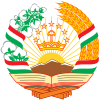Culture of Tajikistan
| Part of a series on |
Tajiks |
|---|
| History and culture |
| Population |
The culture of
Religion
Tajikistan's government has shown intolerance of some religious faiths, such as Jehovah's Witnesses, and has demolished religious buildings.[1]
Cuisine

Tajik cuisine has much in common with
Traditional Tajikistani meals begin with small dishes of dried fruit, nuts, and halva, followed by soup and meat, and finished with plov. Tea accompanies every meal, and is often served between meals as a gesture of hospitality. It is often drunk unsweetened. Tajik cuisine offers a large variety of fruit, meat, and soup dishes.
Sport
Tajikistan's mountains provide many opportunities for outdoor sports, such as
Four Tajikistani athletes have won Olympic medals for their country since independence. They are: wrestler Yusup Abdusalomov (silver in Belijing 2008), judoka Rasul Boqiev (bronze in Beijing 2008), boxer Mavzuna Chorieva (bronze in London 2012) and Dilshod Nazarov (gold in hammer throw in Rio 2016) .
Cinema
Tajikistan's film industry dates from 1929. The first official movie studio, called Tajikkino (later renamed to Tajikfilm), began operation in 1930. In 1935, Tajikkino started producing movies with voice-over.[2] Some experts believe 1970–80 to be the golden age for Tajikfilm. Subsidized by the government, the studio was able to produce about six feature films each year.[3]
Examples of Tajikfilm's success during the Soviet times are such movies as The Legend of Rustam, The Legend of Rustam and Siavoush, and The Legend of the Smith Kova, based on stories from
Among prominent Tajik producers are Valeriy Ahadov and Davlat Khudoynazarov.
After the breakdown of Soviet Union and the civil war in Tajikistan (1992–1997), Tajik cinema went downwards. The studio mainly survived by taking small foreign orders,[2] and produced only a few of its own movies. Mohsen Makhmalbaf's film Sex & Philosophy from 2005 was set and produced in Tajikistan, as was the film Angel on the Right by Jamshed Usmonov from 2002. Other Tajik movies produced in the past two decades include: Kosh ba Kosh (1993), Business trip (1998, documentary), and Luna Papa (1999, a joint project of Tajikfilm with some counterparts from Germany, Austria, Switzerland, Japan, and Russia).[4]
Art
Chakan embroidery is the practice of sewing symbolic images on cotton or silk with brightly colored thread.[5] These depict mythological images, nature, or the cosmos. The embroidery is done on clothing and on common household items such as curtains, bedspreads, and pillows. Chakan items are an important part of marriage ceremonies, with a bride wearing a Chakan shirt and the groom wearing an embroidered skullcap called a "tāqi". Tajik women and girls will commonly wear Chakan clothing during national festivals and holidays.
Women create this art form, either individually or in communal settings.[5] When working individually the craftswomen will get help from their daughters and other family members. In a communal setting the craftswomen gather in one home, taking direction from the most experienced one and being assigned an individual task for the process. These tasks can include image design, fabric cutting, embroidering, sewing garments, and taking orders for the sale of the products. The products created by these craftswomen are sold in bazaars or dress shops, providing an important source of income.
The practice of Chakan embroidery is passed down from one generation of women to the next, to ensure the practice continues to thrive.[5] A craftswoman will pass down her knowledge to her daughter, granddaughter, and daughter-in-law. Chakan embroidery can also be learned in group settings from an expert craftswoman, referred to as the "ustod-shogird" or "master-student" method.
In 2018, Chakan embroidery was inscribed on UNESCO's Representative List of the Intangible Cultural Heritage of Humanity.[5]
Music
Traditional Tajik music is closely related to other Central Asian music forms.
Literature
Traditional centers of Tajik literature were
Cultural revival
One thousand years after the Samanid period, another cultural revival occurred; this time due to the
Since independence, there has been a pre-Soviet cultural revival in an attempt to foster a sense of national identity. Novelist
Gallery
-
A Tajik women in traditional dress.
-
A traditional Tajik wedding.
-
A man makesplov, the national dish of Tajikistan.
-
A monument in Dushanbe to Tajik writers.
See also
- Architecture of Central Asia
- Public holidays in Tajikistan
- Literature of Tajikistan
- Afghan culture
- Uzbek culture
References
- ^ Forum 18 (2007), News Service, retrieved 2007-10-19
{{citation}}: CS1 maint: numeric names: authors list (link) - ^ a b Wikipedia, Russian, Таджикфильм
- ^ Centralasiaonline.com
- ^ "Энциклопедия отечественного кино". Archived from the original on 2011-11-21. Retrieved 2010-12-25.
- ^ a b c d "UNESCO - Chakan, embroidery art in the Republic of Tajikistan". Intangible Cultural Heritage. Retrieved 24 April 2022.





